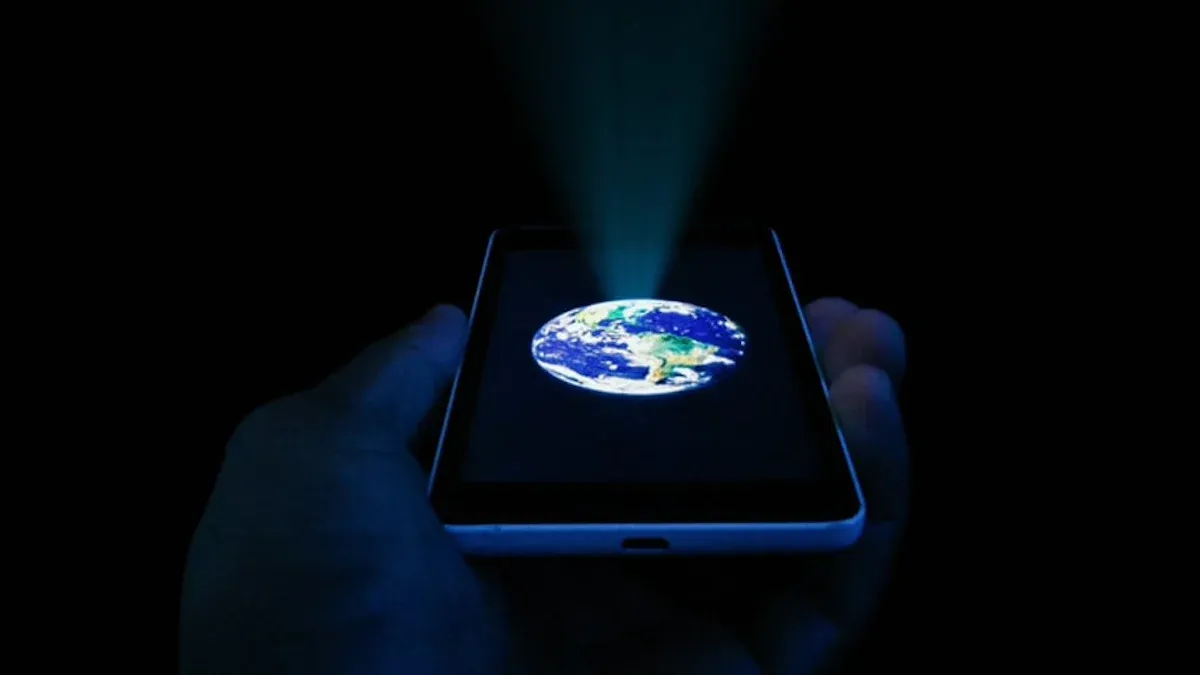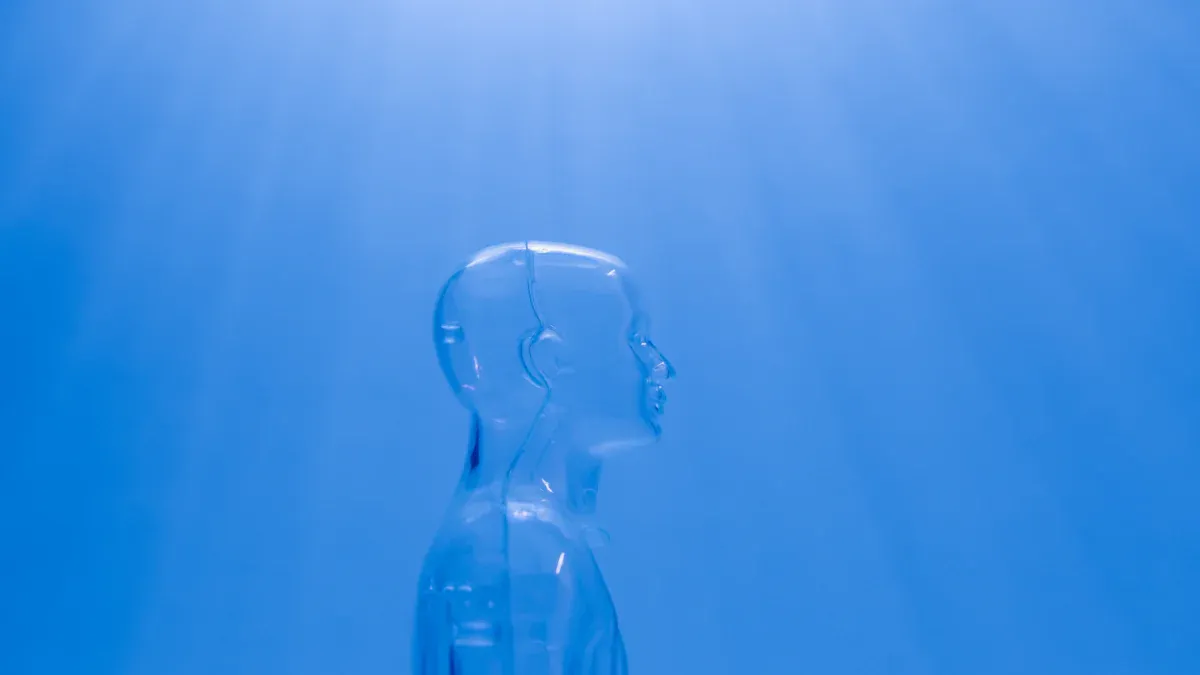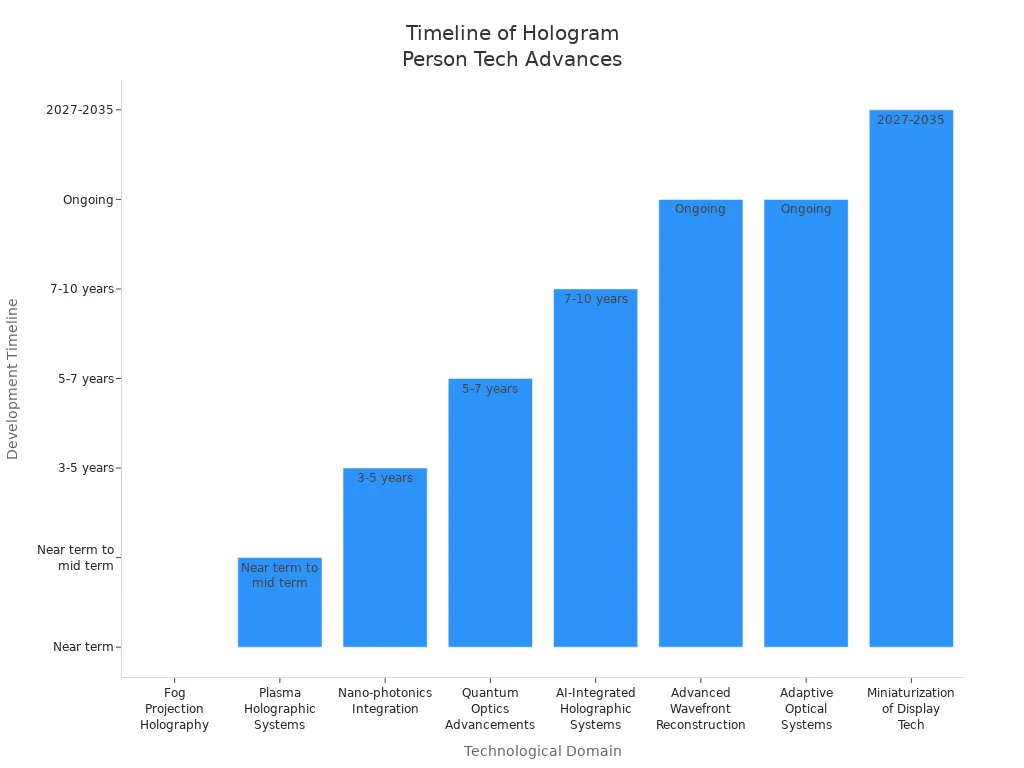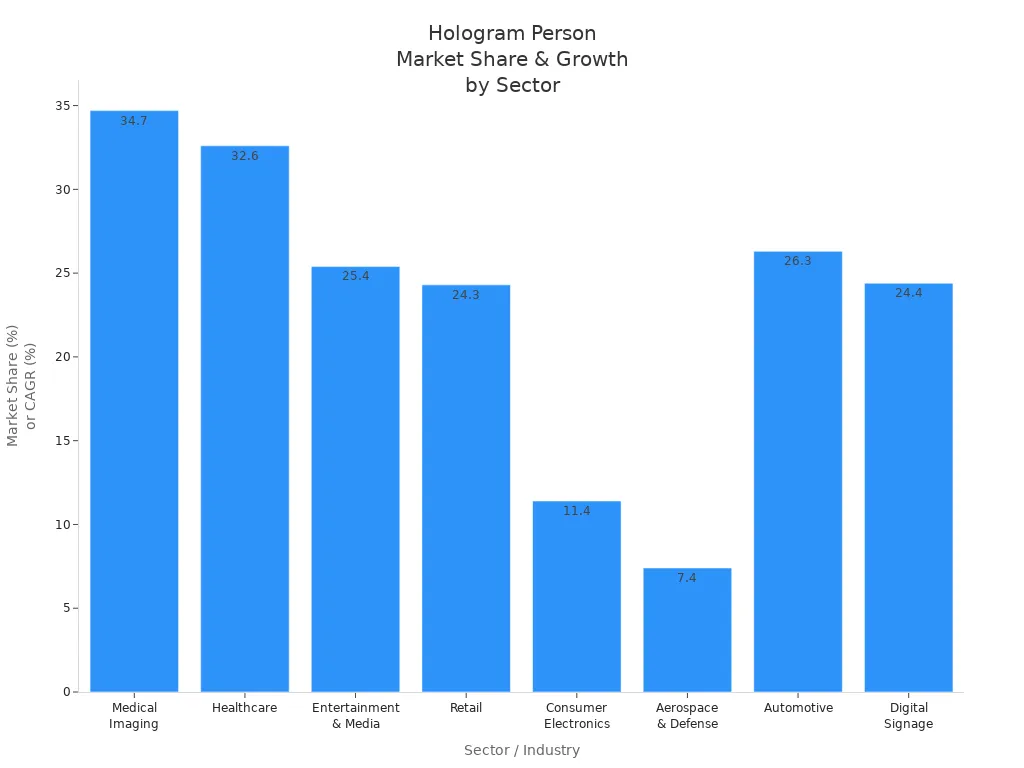


+86 184 7636 4380



Jul. 15, 2025

You may think a hologram person is only in movies, but this technology is real now. New research lets you interact with 3D images that float in the air.
In science fiction, hologram persons look and act like real people. They seem to have their own minds and look very real.
In real life, hologram persons use volumetric displays. These displays let you move, lift, or turn virtual objects. But they do not look as real as the ones in movies.
This progress lets you try technology that once seemed impossible.
Hologram persons are real 3D images. They show up in real space. You can see them from many sides. You do not need special glasses to see them.
They use new technology like volumetric capture and holography. They also use artificial intelligence. This helps make lifelike and interactive experiences.
Today, holograms are used in concerts and schools. They are also used in business meetings and ads. They make events more fun. They help people talk in a more personal way.
Most holograms now only give visual experiences. Real touch and full interaction are not ready yet. People are still working on them.
The future for holograms looks good. They will get clearer and cheaper. AI will help them improve. We may use them more in schools and hospitals. We may also use them in daily life.

A hologram person is not just a picture on a screen. You see a digital human that stands in 3D space. It looks like the person is right in front of you. Big technology companies say a hologram person feels real, not flat. You can look at them from many sides. Sometimes, you can even talk or interact with them.
Here is how experts make a hologram person:
Volumetric Capture: Cameras take videos from many angles. This makes a 3D model of the person.
Holography Technology: Special displays use light to show the 3D image in real space.
Artificial Intelligence Integration: AI lets the hologram person answer your words and feelings. This makes it feel more real and fun.
You can see hologram persons in stores, schools, and concerts. They help you use digital content in new ways.
You may wonder how a hologram person is not the same as a digital human. The biggest difference is how and where you see them. A digital human is on your computer or phone screen. A hologram person shows up in real life as a 3D image you can walk around.
| Aspect | Digital Humans | Hologram Persons |
|---|---|---|
| Nature | Software-based, online | 3D projections in physical space |
| Roles | Virtual assistants, online guides | Live events, remote meetings, concerts |
| Appearance | Can look realistic or animated | Aim for lifelike 3D visuals without special glasses |
| Interaction | Responds to you online | Visual presence, sometimes interactive |
| Viewing Requirements | Needs a screen | No headset or glasses needed |
A hologram person gives you a real and shared experience. You do not need a headset or special device. This makes it easier and more real than digital humans or virtual reality avatars.
You may wonder how a hologram person stands in front of you. The answer is in the science of light and 3D pictures. Scientists use holography to make this happen. Holography copies how light bounces off things. This lets you see a 3D image from many sides.
Engineers use lasers to make a hologram person. Here are the steps in a simple way:
A laser splits into two beams: a reference beam and an object beam.
The object beam shines on the person or thing, then bounces to a special surface.
The reference beam hits the same surface but does not touch the object.
When both beams meet, they make a pattern of light and dark lines.
This pattern is saved on a photosensitive material.
If you shine light on this pattern, it brings back the original light waves. This makes a 3D image appear in the air.
Some new systems use a method called IHLLS. This uses the way light mixes with itself to make very clear 3D images. IHLLS can show fast moves and tiny details without moving parts. This makes the hologram person look more real.
You can see many kinds of holograms today. Here is a table that shows some types and what they do:
| Type of Hologram | Description | Application Example |
|---|---|---|
| Transmission Holograms | You see them by shining laser light through them. They show a lot of detail. | Scientific imaging |
| Reflection Holograms | You see them in normal light. They are used for security and displays. | Credit card holograms |
| Rainbow Holograms | You can see them in white light, but they have less detail up and down. | Color displays |
| Computer-Generated Holograms | Made with computers to show things that are not real. | Virtual objects, simulations |
| Volumetric Displays | Show 3D images in open space. They are often called holograms but use other technology. | 3D visualization, live events |
Tip: Not every 3D image is a real hologram. Some displays only look like holograms. True holography uses light interference to make a 3D effect.
Today, you can see a hologram person at concerts and in classrooms. The technology has improved a lot in recent years. For example, Korean researchers at ETRI made a processor that turns video into 3D holograms right away. This lets you watch a live video call and see the person as a 3D hologram, almost instantly and with lots of detail.
Companies like Axiom Holographics are leaders in making life-sized, interactive hologram persons. Their technology lets you see and talk to a hologram person who moves and reacts like a real person. You can use these systems for live shows, business meetings, or military training. Other companies, like Proto and ARHT, make hologram boxes that show full-size people for teaching or medical care. Google and Microsoft are also trying 3D holographic chats and meetings.
Some researchers in Japan made holograms you can touch. They use lasers to make tiny points of light in the air. You can feel these points with your fingers. This system, called “Fairy Lights,” lets you touch floating images, like pressing a button in the air.
But the technology still has problems. You cannot shake hands with a hologram person and feel a real grip yet. Scientists at UC Santa Barbara found that touch feedback is weak and blurry. Devices that try to add touch, like smart gloves, feel big and not comfortable. Getting sight, sound, and touch to work together is still hard. Most hologram displays cannot show images outside their panels, so the effect is not perfect.
Realistic touch and full interaction are not possible yet.
Devices for tracking your body or gestures can be tricky to use.
Matching sound and movement at the same time is hard.
Smell and taste do not work with today’s hologram person technology.
You will see more progress soon, but for now, a hologram person gives you an amazing visual show, not a fully touchable one.

You can now see concerts with hologram artists on stage. Tupac Shakur and Michael Jackson are famous examples. These shows use motion capture and computer graphics. This helps make 3D images look real. Holograms also appear in theme parks and movies. They make the experience feel more exciting. Companies use holograms for ads too. Nike showed a 3D hologram of Neymar Jr. in a mall. Many people came to see it. Pepsi Max made a bus stop with holograms. People saw things like a giant robot or a tiger. These events show how holograms grab attention and create excitement.
| Sector | Application Examples | Description |
|---|---|---|
| Entertainment | Holographic concerts, movies, theme parks, advertising | Create immersive experiences and engage large audiences. |
Note: Hologram persons in entertainment often use lasers, 3D modeling, and AI. This makes the show feel real.
Hologram persons help with business meetings and conferences. Telepresence lets people appear as 3D holograms far away. Meetings feel more real than video calls. You can see faces and body language. This helps people understand each other better. Companies use systems like TeleHuman 2. It shows a 3D image you can see from any side. This technology saves travel time and money. It helps people connect around the world.
Holographic telepresence brings people together from far away.
Real-time 3D avatars help teams solve problems faster.
In classrooms, hologram persons help students learn in new ways. Teachers can show historical figures or 3D models of the body. Some schools use mixed reality headsets like Microsoft HoloLens 2. These show students or teachers as holograms. Remote learning feels more personal and fun. Projects like HoloLearn make lessons more interesting. Students say holograms help them understand better. Some systems only show the upper body. Sometimes, the image can be slow.
Holograms let you use science models or join class from home.
Teachers can see if students are paying attention and change lessons right away.
New technology like SolidLight makes hologram persons even better. These systems use special panels and software. They create sharp, real 3D images for fun, talking, and learning.
Hologram technology still has many problems. It costs a lot, so most people cannot use it. The equipment is pricey and hard to get. You need special devices and a strong internet connection. This helps everything work well. Some big problems are:
The technology is hard to set up and needs experts.
Devices are heavy and hard to carry.
Displays need a lot of space.
Setting up and taking down takes a long time.
Teams must practice a lot before using it.
Many people feel nervous or unsure about new technology.
If you want holograms in schools or offices, you need special hardware like Microsoft HoloLens 2. You also need safe networks, cloud services, and strong security. These things make it hard for everyone to use holograms.
As hologram technology gets better, you need to think about privacy and fairness. People worry about who owns their digital image. Some are scared others might use their face without asking. You also need to think about how holograms show different cultures. If not done right, this can cause unfair or wrong images.
Other worries are:
Keeping personal data safe and private.
Making sure people say yes before using their image.
Stopping bias in how holograms look or act.
Deciding who controls and makes money from digital faces.
Note: Experts say fixing these problems is as important as making the technology better.
The future for hologram technology looks good. Experts think holograms will soon look almost real. They will have lifelike skin and move naturally. Prices will go down, so more people can use them in schools, hospitals, and businesses. AI will help holograms talk and react to your voice and feelings.
New ideas will help fix today’s problems. Fog projection and plasma systems will make images clearer. Nano-photonics and quantum optics will make details better. Smaller displays may let you use holograms on your phone by 2030.
| Technological Domain | Potential Impact | Estimated Timeline |
|---|---|---|
| Fog Projection Holography | Floating, high-res 3D visuals in open air | Near term |
| Plasma Holographic Systems | Sharp, dynamic 8K images, wide visibility | Near to mid term |
| Nano-photonics Integration | Ultra-high resolution, precise light control | 3-5 years |
| Quantum Optics Advancements | Enhanced realism for scientific visualization | 5-7 years |
| Miniaturization of Display Tech | Holograms in consumer devices like smartphones | 2027-2035 |

Market experts think the digital holography market will grow fast. Education and 3D holography will lead the way. You will probably see more holograms in your life as these changes happen.
You can see this technology is real and growing quickly. Many businesses use 3D displays for things like medicine, fun, shopping, and more.
| Sector / Industry | Key Uses of Hologram Persons / Holographic Displays | Market Share / Growth Insights (2024 or CAGR to 2034) |
|---|---|---|
| Medical Imaging & Healthcare | 3D views of CT or MRI scans, surgery planning, helping doctors during operations, better tests, brain and bone surgery | This area leads with 34.7% of the market (medical imaging) and 32.6% of the money (healthcare) |
| Entertainment & Media | Live shows with artist holograms, concerts with famous holographic stars, making shows more exciting | Expected to grow by 25.4% each year until 2034 |
| Retail | 3D product displays you can see and touch, helping customers, seeing products before buying | Expected to grow by 24.3% each year until 2034 |
| Consumer Electronics | Used in phones, smartwatches, TVs, tablets; better 3D games, AR apps | 11.4% of the market in 2024; Smart TV growth 23.8% each year |
| Aerospace & Defense | Training with 3D images, better choices and learning for pilots and soldiers | 7.4% of the market in 2024 |
| Automotive | Heads-up displays, maps, cockpit screens, car design and testing | Big growth in Japan and North America; Japan grows by 26.3% each year |
| Digital Signage | Ads and brand messages with bright, moving holograms | Expected to grow by 24.4% each year until 2034 |
| Education | 3D models for science, engineering, and history to help students learn | More schools in South Africa and other places are using it |
| Cultural Tourism & Event Marketing | Museums, shows, virtual tours, city planning, and property tours | More use in the Middle East, Mexico, and Saudi Arabia |

There are still problems like high prices, hard setups, and no shared rules.
| Challenge Category | Description |
|---|---|
| High Implementation Costs | Starting needs costly tools like lasers, special glass, and strong computers, so small businesses cannot afford it. |
| Technical Complexity | Making clear 3D images and hologram content needs experts and special programs, which makes it cost more to build and run. |
| Skilled Manpower Requirement | Keeping things working right needs trained workers, which adds to the cost. |
| Lack of Universal Standards | No shared rules means different systems do not work together, making it hard to make and share content. |
| System Fragmentation | Companies use their own systems that do not connect, so sharing and building costs more. |
| Perceived Low ROI | Cheaper options like 2D or AR seem better for now, so people wait for lower prices before using holograms. |
Experts say you should learn new skills and be ready for change.
Use ways to check if customers, companies, and workers get value.
Try to learn and adjust to new things.
Be open to new ideas and keep learning.
Lead with flexibility and care.
Think about safety, data, and how people feel about new tech.
Make plans and use new tools in smart ways.
A hologram stands in real space as a 3D image you can walk around. An AR image appears on your phone or headset screen and blends with the real world. You do not need special glasses for a hologram.
You cannot truly touch a hologram person yet. Some labs let you feel tiny points of light, but you will not feel a real handshake. Most holograms today only give you a visual experience.
Hologram systems cost a lot. You may pay thousands of dollars for the equipment and setup. Most schools and small businesses cannot afford it yet. Prices may drop as the technology improves.
Yes, hologram persons use safe light levels. You do not need to worry about eye damage. You should always follow safety tips from the device maker.
You can see hologram persons at concerts, museums, trade shows, and some schools. Some companies use them for business meetings or special events. You may also find them in shopping malls or science centers.
Please leave your request for any product you wish. We will be happy to search it for you in our databases or offer its custom synthesis
